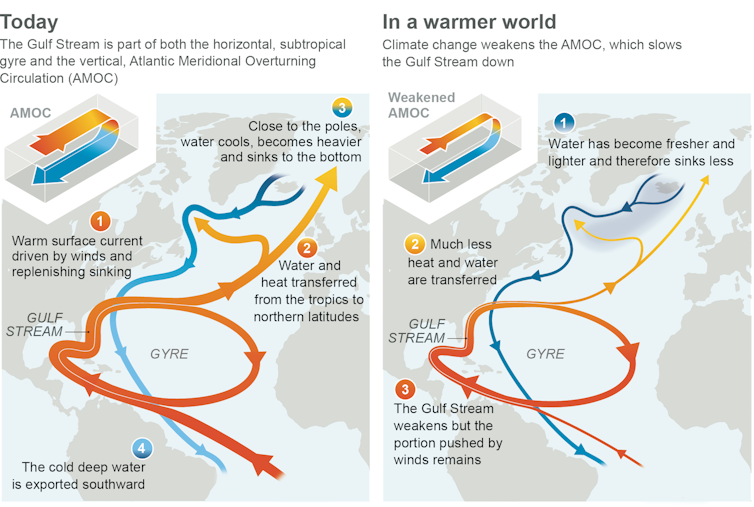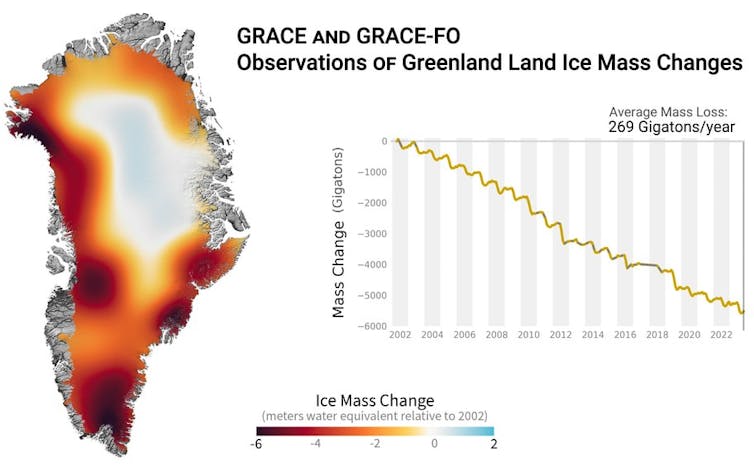When people think about the risks of climate change, the idea of abrupt changes is pretty scary. Films like “The Morning After” feed this fear, with visions of unimaginable storms and populations fleeing to escape rapid temperature changes.
While Hollywood clearly takes liberties with the speed and scale of disasters, several recent studies have sounded the alarm that a crucial ocean current that circulates heat to the Global North could stop within this century, with potentially disastrous consequences.
This scenario has occurred in the past, most recently over 16,000 years ago. However, this depends on Greenland releasing a lot of ice into the ocean.
Our new research, published in the journal Science, suggests that although Greenland is currently losing huge and worrying amounts of ice, this may not continue long enough to stop the flow on its own. A closer look at the evidence from the past shows why.
Blood and water
The Atlantic Current system distributes heat and nutrients globally, just as the human circulatory system distributes heat and nutrients throughout the body.
Warm water from the tropics flows northward along the Atlantic coast of the United States before crossing the Atlantic. As some of the warm water evaporates and the surface water cools, it becomes saltier and denser. Denser water sinks, and this colder, denser water flows southward at depth. Variations in heat and salinity fuel the pumping core of the system.
If the Atlantic circulation system weakens, it could lead to a world of climate chaos.

6th IPCC assessment report
Ice sheets are made of fresh water, so the rapid release of icebergs into the Atlantic Ocean can reduce ocean salinity and slow heart rates. If surface waters can no longer sink deeper and circulation collapses, dramatic cooling will likely occur in Europe and North America. The Amazon rainforest and Africa’s Sahel region would become drier, and the warming and melting of Antarctica would accelerate, all within a few years or even decades.
Today, Greenland’s ice sheet is melting rapidly, and some scientists fear the Atlantic current system is heading toward a climate tipping point this century. But is this concern justified?
To answer this question, we have to go back in time.
A radioactive discovery
In the 1980s, a young scientist named Hartmut Heinrich and his colleagues extracted a series of sediment cores from the seafloor to study whether nuclear waste could be safely buried in the depths of the North Atlantic.
Sediment cores contain the history of everything that has accumulated on this part of the ocean floor over hundreds of thousands of years. Heinrich found several layers containing numerous mineral grains and rock fragments from the earth.
The sediment grains were too large to have been transported to the middle of the ocean by wind or ocean currents alone. Heinrich realized that they must have been brought there by icebergs, which had picked up the rock and minerals while the icebergs were still part of the land’s glaciers.
The layers containing the most rock and mineral debris, dating from a time when icebergs were expected to emerge in force, coincided with a strong weakening of the Atlantic current system. These periods have come to be known as the Heinrich events.
As paleoclimate scientists, we use natural records such as sediment cores to understand the past. By measuring uranium isotopes in the sediments, we were able to determine the deposition rate of sediments left behind by icebergs. The amount of debris allowed us to estimate the amount of fresh water these icebergs added to the ocean and compare it with today to assess whether history could repeat itself in the near future.
Why a shutdown is not likely anytime soon
So, is the Atlantic current system heading towards a climatic tipping point due to the melting of Greenland? We believe this is unlikely in the coming decades.
While Greenland is currently losing huge volumes of ice – comparable to a mid-range Heinrich event – ice loss likely will not continue long enough to stop the flow on its own.
Icebergs are much more effective at disrupting the current than meltwater from land, in part because they can carry fresh water directly to where the current is flowing. However, future warming will force the Greenland ice sheet to move away from the coast too soon for icebergs to provide enough fresh water.

NASA
The strength of the Atlantic Southern Overturning Circulation, or AMOC, is expected to decrease by 24% to 39% by 2100. By then, Greenland’s iceberg formation will be closer to the weaker Heinrich events the past. The Heinrich events, on the other hand, lasted about 200 years.
Instead of icebergs, meltwater flowing into the Atlantic at the edge of the island is expected to become the main cause of Greenland’s thinning. Melt water still sends fresh water into the ocean, but it mixes with seawater and tends to move along the coast rather than directly refreshing the ocean as do drifting icebergs.
This does not mean that the current is not in danger
The future trajectory of the Atlantic current system will likely be determined by a combination of decelerating, but more effective, icebergs and accelerating, but less influential, surface runoff. This situation will be worsened by rising ocean surface temperatures, which could further slow the current.
So the Earth’s core could still be in danger, but history suggests the risk is not as imminent as some fear.
In “The Next Day”, a slowdown in the Atlantic Current system has frozen New York City. Based on our research, we can take comfort in knowing that such a scenario is unlikely in our lifetime. However, vigorous efforts to stop climate change remain necessary to ensure that future generations are protected.